|
Collecting the World’s First
Typewriters
By Martin Howard ©2008
Collecting antique typewriters has really come of age
in the last 20 years, as the appreciation of antique machines
has grown in our technological times of smooth cases and
blinking lights. There were a few typewriter collectors 50
years ago, but they could have been counted on one hand.
Today, there are over 500 typewriter collectors spread around
the world. The largest group of collectors is found in the
U.S. and Germany, but there is strong interest throughout
Europe, especially in Italy, France, Spain and Switzerland.
Most typewriter collectors seek machines from the 1880s and
1890s, the first 20 years of typewriter manufacturing, a time when
the fundamental design of the “modern” typewriter had yet to be
discovered. During this time, there was a major effort by many
pioneering machinists and engineers to create a viable typewriter
for a world that was ready for this revolutionary machine.
There are perhaps 400 different models to collect from this
age of experimentation. These typewriters were manufactured
in many industrialized countries, in particular the U.S.,
England and Germany. Today, the values of these machines
are affected by condition, rarity and desirability with prices
ranging from a few hundred dollars to into the thousands for the rare machines. However, for those interested in acquiring
an early typewriter at a modest price, there are a number of
intriguing and historically important typewriters that can be
had for a few hundred dollars, including the Blickensderfer
($150 to $250), Hammond ($150 to $500), and Odell ($400
to $600). EBay is a good place to look for these and others.
By 1910, the design of most typewriters had become
standardized as a result of the emergence of the ubiquitous and
brilliant Underwood 1, which appeared in 1897. All typewriters
from now on, right up to the invention of the personal computer
in the early 1980s, would ostensibly have the same look and
function as the Underwood. The age of experimentation was over.
Unique American typewriter goes to the auction block.
This past November, a very special typewriter went for auction
in Germany. It was the typewriter of U.S. inventor Abner
Peeler. His very strange typing machine was made in 1866 and
is one of the very first typewriters made. This typewriter was
not manufactured, though, and only one example is known to
exist. Mr. Peeler also has the distinction of mailing the first
typed letter in the U.S., which was sent on June 19, 1866.
The letter begins: “Dear Companion, We are both well. I feel
splendid. I am now in the office of Chipman & Co. The machine has
been examined by a great may shrewd men and they think it is the
greatest curiosity of the age. They also think it is of great value.”
The “shrewd men” were right, but it would not be his
machine that would herald in the age of the typewriter; that
would be a few years later in 1874 when the American printer
Christopher Lathem Sholes had his very functional typewriter,
the Sholes & Glidden, manufactured by Remington & Sons.
Mr. Peeler also created the very first airbrush machine and
his impressive self-portrait, from a photo, is the first airbrush
picture in history. One can read more about the Peeler collection
and see his typewriter and self-portrait at www.abnerpeeler.com.
The first typewriters, a brief history. The keyboard provides
an essential means for one to communicate and is used by more
people today then ever before. Keyboards are arguably one of
the most important tools in the world, a tool that represents our
personal communication in this technological age. The keyboard truly connects the planet. But what did the first keyboards and typewriters look like
and how did they evolve?
Typewriters from the
1930s and ‘40s all look pretty
much the same with four rows
of straight keys, single shift
and front strike visible (typebars
hit the front of the roller
allowing one to see what they
have just typed). Typewriters
have not always looked like
this, though. Just imagine
if you, never having seen a
typing machine, were asked
to design one. How might it
look? In fact, the standard
big, black machines you are
familiar with, such as the
Underwood and Remington,
were the result of many years
of mechanical evolution.
During these early years
of discovery, ingenuity and
mistakes, more than 400
different typing machines
were produced to print the
written word. Among them
were machines with curved
keyboards, double keyboards
or no keyboards at all!
The first typewriter
patent was issued to an English
engineer, Henry Mill in 1714.
He outlined the concept of the
typewriter when he registered
a patent for “…an artificial
machine for impressing
letters one after another, as in
writing, whereby all writings
may be engrossed in paper or
parchment, so neat and exact
as not to be distinguished
from print.” However, this
machine was never made.
Many experimental
typewriters were built and
used during the first 75 years
of the 19th century, but none
were produced in quantity.
This was about to change
though, as the technology for
mass production had arrived,
and the need for fast, accurate
business communication was
growing. What was needed
was a person to bring together
all of the successful elements
that had been developed so far.
The Sholes & Glidden
typewriter. This person
was Christopher Sholes, an
American printer living in
Milwaukee. After a shaky start
with a number of experimental
prototype machines, Sholes
was advised by his financial
backer Glidden, to have his
typewriter produced by E.
Remington & Sons. This was
wise advice as the Remington factory was well equipped
to mass-produce complex
machines, having already set
up production facilities to
manufacture guns and later
sewing machines. With the
American Civil War over and
the need for guns diminished, Remington was eager for new business
opportunities and embraced the challenge.
In 1874, one thousand Sholes &
Glidden typewriters came out of the
Remington factory. This typewriter was a
beautiful object, all black and covered with
hand painted floral decorations. A cast iron
foot treadle operated the carriage return.
The influence of the sewing machine on
its design was clear. To see what had
been typed, it was necessary to lift up
the carriage and look under the roller,
as the type-bars struck on the underside.
The Sholes and Glidden was also
the first typewriter with the “Qwerty”
keyboard. The purpose of this layout was
to minimize the type-bars from clashing
with each other while typing by separating
the type-bars for letters that are frequently
typed in sequence; for example, “t” and
“h”. Attempts were made to introduce more
sensible keyboard layouts once typewriter
designs had evolved, but it was too late;
people had already learned one way and
understandably did not want to learn again.
The start was slow for the typewriter.
The Sholes & Glidden was not a quick hit and sold very slowly to start and then with
only moderate success. Competition did
not arrive until 1881 when the Caligraph 1
appeared. However, during the following
20 years everything changed, as the
industrial world realized that the typewriter
was indispensable and that there was a
huge market to satisfy.
The index typewriter. Full keyboard
typewriters were very expensive in their
day, costing between $60 and $120. In
comparison, a clerk’s wage was $5 a
week, horse drawn carriages cost between
$40 and $70, and a massive cast iron
coal furnace for one’s house was $50.
With few secondhand machines to be
had, a less expensive machine was needed.
Thus, the “index” typewriter was born.
This typewriter had no keyboard. Instead,
a dial or knob was turned to select the
character that was to be printed. Typing
was slow (around 20 words a minute), but
the cost was right at $5 to $30. If one had
poor handwriting, speed was not the only
issue, though, as one could now produce
legible typed work. The index machine
was popular for small businesses and home
use during the 1880s and 1890s with many
remarkable designs being produced, but as
secondhand keyboard machines became
available and touch-typing was introduced
at the turn-of-the-century, the market for
the index typewriter quickly disappeared.
In search of standardization. There
were many brilliant mechanical engineers
who became typewriter pioneers when
they applied their skills to the rapidly
growing typewriter industry of the late
19th century. The inventors, having to
avoid patent infringements and pursuing
their own notion of the better typewriter,
created many ingenious mechanisms
to get the printed word onto paper.
There was little, if any, apparent design
progression for these first typewriters.
A great variety of machines were
invented, out of which the most efficient
combinations of mechanisms were
gradually selected. Some mechanisms,
too advanced, disappeared until a later
time. Each mechanism solved a particular
problem, but not always in the best way.
There were notable successes and failures.
By 1896, many components,
combinations and designs had been tried
and the winner was emerging. A typewriter
with the correct combination of successful
components, a typewriter that was fast and
wonderful to type on, a typewriter that
would usher in the new century, conquer
the world, and put an end to this period
of rich diversity in typewriter history. The
Underwood had arrived.
Martin Howard would be pleased to
answer questions about
antique typewriters.
His email is
martin@antiquetypewriters.com. His
collection is featured at
antiquetypewriters.com.
|
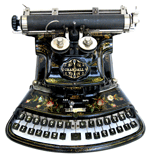
Crandall New Model, Croton N.Y., 1886, the first typewriter with a single type element (no type-bars), similar to the
IBM “Golf Ball” technology of the early 1960s.
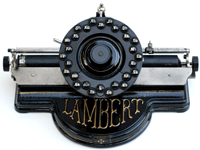
Lambert 1, New York, N.Y., 1902. Frank Lambert, a
French immigrant, spent 17 years developing the Lambert
typewriter. The phone-like dial is spring-loaded and
depressed to type, not turned.
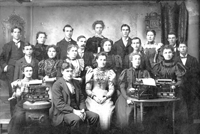
A typing class, ca. 1890. There was a great need for trained
typists, attracting both men and women to this new
profession. (Photo: courtesy of the Peter Weil Collection.)
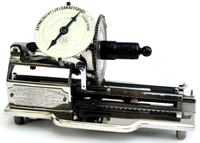
Columbia 2, New York, N.Y., 1885. This was
the first typewriter invented by Charles Spiro,
a New York watchmaker, who went on to create
many superb typewriters.
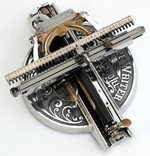
Odell 2, Chicago, 1890; a nickel-plated
index typewriter with an Art Nouveaustyled
base.
|